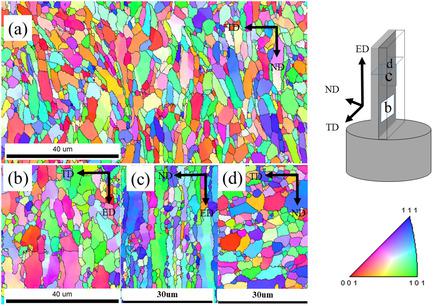当前位置:
X-MOL 学术
›
Adv. Eng. Mater.
›
论文详情
Our official English website, www.x-mol.net, welcomes your feedback! (Note: you will need to create a separate account there.)
Influence of a Hot Extrusion with Rectangular‐Section on Mechanical Properties and Microstructure of 0.5 wt% Graphene Nanoplate‐Reinforced Aluminum Composites
Advanced Engineering Materials ( IF 3.6 ) Pub Date : 2020-12-18 , DOI: 10.1002/adem.202001127 Shumei Lou 1 , Yongqiang Liu 1 , Chuandong Qu 1 , Guangxin Guo 1 , Lingwei Ran 1 , Pingping Zhang 1 , Chunjian Su 1
Advanced Engineering Materials ( IF 3.6 ) Pub Date : 2020-12-18 , DOI: 10.1002/adem.202001127 Shumei Lou 1 , Yongqiang Liu 1 , Chuandong Qu 1 , Guangxin Guo 1 , Lingwei Ran 1 , Pingping Zhang 1 , Chunjian Su 1
Affiliation

|
A hot extrusion process for obtaining rectangular cross‐sections is applied to a graphene nanoplate (GNP)‐reinforced aluminum (Al) composite (GNP/Al) composite. After extrusion, the GNP dispersion is more uniform and its layer number decreases, whereas the proportion of small grains increases; the composite and pure aluminum exhibit a typical extrusion texture. Distinct equiaxed grains, which are attributed to graphene presence, are visible on the composite section in the extrusion normal direction, whereas the pure aluminum presents spindle‐shaped grain in the same direction. Certain high‐disorientation angles are generated, indicating the occurrence of dynamic recrystallization during the extrusion process. The tensile strength of the GNP/Al composite is moderately improved (11.2%), whereas its plasticity increases insignificantly. This relative small enhancement is attributed to the relative small extrusion ratio. The amount of strength reinforcement (induced by hot extrusion) calculates by the shear lag model is in good agreement with the experimental results, indicating that the shear lag strengthening model can accurately predict the strengthening effect of the hot extrusion process.
中文翻译:

矩形截面热挤压对0.5 wt%石墨烯纳米板增强铝复合材料的力学性能和微观结构的影响
将获得矩形横截面的热挤压工艺应用于石墨烯纳米板(GNP)增强的铝(Al)复合材料(GNP / Al)复合材料。挤出后,GNP分散更均匀,层数减少,而小晶粒的比例增加;复合材料和纯铝具有典型的挤压纹理。在挤出法线方向上在复合材料截面上可以看到归因于石墨烯存在的不同等轴晶粒,而纯铝在相同方向上呈现纺锤形晶粒。某些特定的高取向角会产生,这表明在挤出过程中发生了动态再结晶。GNP / Al复合材料的拉伸强度得到适度提高(11.2%),而其可塑性却没有明显增加。这种相对小的增强归因于相对小的挤出率。剪切滞后模型计算出的强度增强量(由热挤压引起)与实验结果吻合较好,表明剪切滞后强化模型可以准确预测热挤压过程的强化效果。
更新日期:2020-12-18
中文翻译:

矩形截面热挤压对0.5 wt%石墨烯纳米板增强铝复合材料的力学性能和微观结构的影响
将获得矩形横截面的热挤压工艺应用于石墨烯纳米板(GNP)增强的铝(Al)复合材料(GNP / Al)复合材料。挤出后,GNP分散更均匀,层数减少,而小晶粒的比例增加;复合材料和纯铝具有典型的挤压纹理。在挤出法线方向上在复合材料截面上可以看到归因于石墨烯存在的不同等轴晶粒,而纯铝在相同方向上呈现纺锤形晶粒。某些特定的高取向角会产生,这表明在挤出过程中发生了动态再结晶。GNP / Al复合材料的拉伸强度得到适度提高(11.2%),而其可塑性却没有明显增加。这种相对小的增强归因于相对小的挤出率。剪切滞后模型计算出的强度增强量(由热挤压引起)与实验结果吻合较好,表明剪切滞后强化模型可以准确预测热挤压过程的强化效果。



























 京公网安备 11010802027423号
京公网安备 11010802027423号